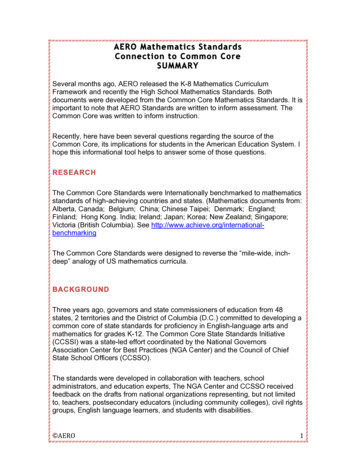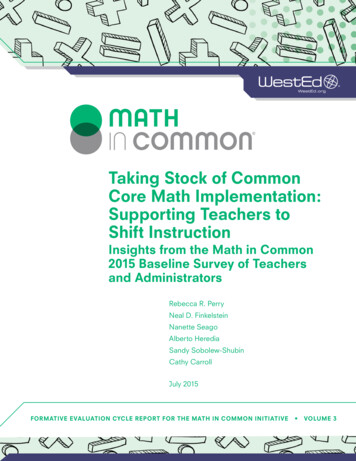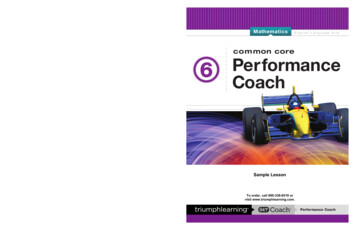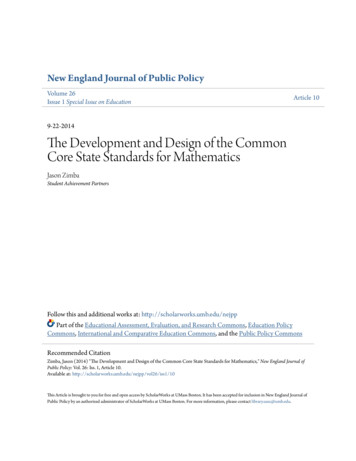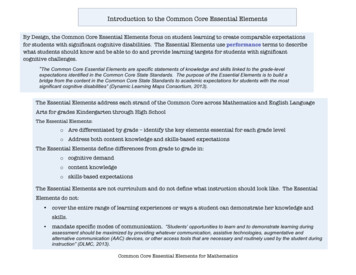
Transcription
Introduction to the Common Core Essential ElementsBy Design, the Common Core Essential Elements focus on student learning to create comparable expectationsfor students with significant cognitive disabilities. The Essential Elements use performance terms to describewhat students should know and be able to do and provide learning targets for students with significantcognitive challenges.“The Common Core Essential Elements are specific statements of knowledge and skills linked to the grade-levelexpectations identified in the Common Core State Standards. The purpose of the Essential Elements is to build abridge from the content in the Common Core State Standards to academic expectations for students with the mostsignificant cognitive disabilities” (Dynamic Learning Maps Consortium, 2013).The Essential Elements address each strand of the Common Core across Mathematics and English LanguageArts for grades Kindergarten through High SchoolThe Essential Elements:o Are differentiated by grade – identify the key elements essential for each grade levelo Address both content knowledge and skills-based expectationsThe Essential Elements define differences from grade to grade in:o cognitive demando content knowledgeo skills-based expectationsThe Essential Elements are not curriculum and do not define what instruction should look like. The EssentialElements do not: cover the entire range of learning experiences or ways a student can demonstrate her knowledge andskills. mandate specific modes of communication. “Students’ opportunities to learn and to demonstrate learning duringassessment should be maximized by providing whatever communication, assistive technologies, augmentative andalternative communication (AAC) devices, or other access tools that are necessary and routinely used by the student duringinstruction” (DLMC, 2013).Common Core Essential Elements for Mathematics
KindergartenCommon Core Essential Elements for Mathematics
Kindergarten Mathematics Domain: Counting and CardinalityCCSS Grade-Level StandardsCommon Core Essential ElementsCLUSTER: Know number names and the count sequence.K.CC.1. Count to 100 by ones and by tens.EE.K.CC.1. Starting with one, count to 10 by ones.K.CC.2. Count forward beginning from a given number within the known sequence (instead ofhaving to begin at 1).Not applicable.See EE.2.NBT.2.b.K.CC.3. Write numbers from 0 to 20. Represent a number of objects with a written numeral 0–20(with 0 representing a count of no objects).Not applicable.See EE.2.NBT.3.CLUSTER: Count to tell the number of objects.K.CC.4. Understand the relationship between numbers and quantities; connect counting tocardinality.K.CC.4.a. When counting objects, say the number names in the standard order, pairing eachobject with one and only one number name and each number name with one and only oneobject.K.CC.4.b. Understand that the last number name said tells the number of objects counted.The number of objects is the same regardless of their arrangement or the order in which theywere counted.EE.K.CC.4. Demonstrate one-to-onecorrespondence, pairing each object with one andonly one number and each number with one andonly one object.K.CC.4.c. Understand that each successive number name refers to a quantity that is onelarger.K.CC.5. Count to answer “how many?” questions about as many as 20 things arranged in a line,a rectangular array, or a circle, or as many as 10 things in a scattered configuration; given anumber from 1–20, count out that many objects.EE.K.CC.5. Count out up to three objects from alarger set, pairing each object with one and onlyone number name to tell how many.CLUSTER: Compare numbers.K.CC.6. Identify whether the number of objects in one group is greater than, less than, or equal tothe number of objects in another group, e.g., by using matching and counting strategies.11EE.K.CC.6. Identify whether the number of objectsin one group is more or less than (when thequantities are clearly different) or equal to thenumber of objects in another group.Include groups with up to ten objects.Common Core Essential Elements for Mathematics
Kindergarten Mathematics Domain: Counting and CardinalityCCSS Grade-Level StandardsK.CC.7. Compare two numbers between 1 and 10 presented as written numerals.Common Core Essential ElementsNot applicable.See EE.2.NBT.4.Common Core Essential Elements for Mathematics
Kindergarten Mathematics Domain: Operations and Algebraic ThinkingCCSS Grade-Level StandardsCommon Core Essential ElementsCLUSTER: Understand addition as putting together and adding to, and understand subtraction as taking apart and taking from.K.OA.1. Represent addition and subtraction with objects, fingers, mental images, drawings2,sounds (e.g., claps), acting out situations, verbal explanations, expressions, or equations.EE.K.OA.1. Represent addition as “puttingtogether” or subtraction as “taking from” ineveryday activities.K.OA.2. Solve addition and subtraction word problems, and add and subtract within 10, e.g., byusing objects or drawings to represent the problem.Not applicableSee EE.2.NBT.6–7.K.OA.3. Decompose numbers less than or equal to 10 into pairs in more than one way, e.g., byusing objects or drawings, and record each decomposition by a drawing or equation (e.g., 5 2 3 and 5 4 1).Not applicable.See EE.1.NBT.6.K.OA.4. For any number from 1 to 9, find the number that makes 10 when added to the givennumber, e.g., by using objects or drawings, and record the answer with a drawing or equation.Not applicable.See EE.1.NBT.2.K.OA.5. Fluently add and subtract within 5.Not applicable.See EE.3.OA.4.2Drawings need not show details but should show the mathematics in the problem. (This applies wherever drawings are mentioned in the Standards.)Common Core Essential Elements for Mathematics
Kindergarten Mathematics Domain: Number and Operations in Base TenCCSS Grade-Level StandardsCommon Core Essential ElementsCLUSTER: Work with numbers 11–19 to gain foundations for place value.K.NBT.1. Compose and decompose numbers from 11 to 19 into ten ones and some further ones,e.g., by using objects or drawings, and record each composition or decomposition by a drawing or Not applicable.equation (such as 18 10 8); understand that these numbers are composed of ten ones andSee EE.1.NBT.4 and EE.1.NBT.6.one, two, three, four, five, six, seven, eight, or nine ones.Common Core Essential Elements for Mathematics
Kindergarten Mathematics Domain: Measurement and DataCCSS Grade-Level StandardsCommon Core Essential ElementsCLUSTER: Describe and compare measurable attributes.K.MD.1. Describe measurable attributes of objects, such as length or weight. Describe severalmeasurable attributes of a single object.K.MD.2. Directly compare two objects with a measurable attribute in common, to see which objecthas “more of”/“less of” the attribute, and describe the difference. For example, directly comparethe heights of two children, and describe one child as taller/shorter.EE.K.MD.1-3. Classify objects according toattributes (big/small, heavy/light).CLUSTER: Classify objects and count the number of objects in each category.K.MD.3. Classify objects into given categories; count the numbers of objects in each category and EE.K.MD.1-3. Classify objects according tosort the categories by count.3attributes (big/small, heavy/light).3Limit category counts to be less than or equal to 10.Common Core Essential Elements for Mathematics
Kindergarten Mathematics Domain: GeometryCCSS Grade-Level StandardsCommon Core Essential ElementsCLUSTER: Identify and describe shapes (squares, circles, triangles, rectangles, hexagons, cubes, cones, cylinders, and spheres).K.G.1. Describe objects in the environment using names of shapes, and describe the relativepositions of these objects using terms such as above, below, beside, in front of, behind, and nextto.Not applicable.See EE.1.G.a.K.G.2. Correctly name shapes regardless of their orientations or overall size.EE.K.G.2–3. Match shapes of same size andorientation (circle, square, rectangle, triangle).K.G.3. Identify shapes as two-dimensional (lying in a plane, “flat”) or three-dimensional (“solid”).CLUSTER: Analyze, compare, create, and compose shapes.K.G.4. Analyze and compare two- and three-dimensional shapes, in different sizes andorientations, using informal language to describe their similarities, differences, parts (e.g., numberof sides and vertices/“corners”) and other attributes (e.g., having sides of equal length).Not applicable.See EE.7.G.1.K.G.5. Model shapes in the world by building shapes from components (e.g., sticks and clayballs) and drawing shapes.Not applicable.K.G.6. Compose simple shapes to form larger shapes. For example, “Can you join these twotriangles with full sides touching to make a rectangle?”Not applicable.See EE.1.G.3.Common Core Essential Elements for Mathematics
First GradeCommon Core Essential Elements for Mathematics
First Grade Mathematics Domain: Operations and Algebraic ThinkingCCSS Grade-Level StandardsCommon Core Essential ElementsCLUSTER: Represent and solve problems involving addition and subtraction.1.OA.1. Use addition and subtraction within 20 to solve word problems involving situations ofadding to, taking from, putting together, taking apart, and comparing, with unknowns in allpositions, e.g., by using objects, drawings, and equations with a symbol for the unknown numberto represent the problem.1.OA.2. Solve word problems that call for addition of three whole numbers whose sum is lessthan or equal to 20, e.g., by using objects, drawings, and equations with a symbol for theunknown number to represent the problem.EE.1.OA.1.a. Represent addition and subtractionwith objects, fingers, mental images, drawings,sounds (e.g., claps), or acting out situations.EE.1.OA.1.b. Recognize two groups that have thesame or equal quantity.EE.1.OA.2. Use “putting together” to solve problemswith two sets.CLUSTER: Understand and apply properties of operations and the relationship between addition and subtraction.1.OA.3. Apply properties of operations as strategies to add and subtract.4 Examples: If 8 3 11 is known, then 3 8 11 is also known. (Commutative property of addition.) To add 2 6 4, the second two numbers can be added to make a 10, so 2 6 4 2 10 12. (Associativeproperty of addition.)Not applicable.See EE.6.EE.3 and EE.N-CN.2.1.OA.4. Understand subtraction as an unknown-addend problem. For example, subtract 10 – 8by finding the number that makes 10 when added to 8.Not applicable.See EE.1.NBT.4 and EE.1.NBT.6.4Students need not use formal terms for these properties.Common Core Essential Elements for Mathematics
First Grade Mathematics Domain: Operations and Algebraic ThinkingCCSS Grade-Level StandardsCommon Core Essential ElementsCLUSTER: Add and subtract within 20.1.OA.5. Relate counting to addition and subtraction (e.g., by counting on 2 to add 2).EE.1.OA.5.a. Use manipulatives or visualrepresentations to indicate the number that resultswhen adding one more.EE.1.OA.5.b. Apply knowledge of “one less” tosubtract one from a number.1.OA.6. Add and subtract within 20, demonstrating fluency for addition and subtraction within 10.Use strategies such as counting on; making ten (e.g., 8 6 8 2 4 10 4 14);decomposing a number leading to a ten (e.g., 13 – 4 13 – 3 – 1 10 – 1 9); using therelationship between addition and subtraction (e.g., knowing that 8 4 12, one knows 12 – 8 4); and creating equivalent but easier or known sums (e.g., adding 6 7 by creating the knownequivalent 6 6 1 12 1 13).Not applicable.See EE.3.OA.4.CLUSTER: Work with addition and subtraction equations.1.OA.7. Understand the meaning of the equal sign, and determine if equations involving additionand subtraction are true or false. For example, which of the following equations are true andwhich are false? 6 6, 7 8 – 1, 5 2 2 5, 4 1 5 2.Not applicable.See EE.1.OA.1.b and EE.2.NBT.5.a.1.OA.8. Determine the unknown whole number in an addition or subtraction equation relatingthree whole numbers. For example, determine the unknown number that makes the equationtrue in each of the equations 8 ? 11, 5 – 3, 6 6 .Not applicable.See EE.3.OA.4.Common Core Essential Elements for Mathematics
First Grade Mathematics Domain: Number and Operations in Base TenCCSS Grade-Level StandardsCommon Core Essential ElementsCLUSTER: Extend the counting sequence.EE.1.NBT.1.a. Count by ones to 30.1.NBT.1. Count to 120, starting at any number less than 120. In this range, read and writenumerals, and represent a number of objects with a written numeral.EE.1.NBT.1.b. Count as many as 10 objects andrepresent the quantity with the correspondingnumeral.CLUSTER: Understand place value.1.NBT.2. Understand that the two digits of a two-digit number represent amounts of tens andones. Understand the following as special cases:1.NBT.2.a. 10 can be thought of as a bundle of ten ones—called a “ten.”1.NBT.2.b. The numbers from 11 to 19 are composed of a ten and one, two, three, four, five,six, seven, eight, or nine ones.EE.1.NBT.2. Create sets of 10.1.NBT.2.c. The numbers 10, 20, 30, 40, 50, 60, 70, 80, 90 refer to one, two, three, four, five,six, seven, eight, or nine tens (and 0 ones).1.NBT.3. Compare two two-digit numbers based on meanings of the tens and ones digits,recording the results of comparisons with the symbols , , and .EE.1.NBT.3. Compare two groups of 10 or feweritems when the number of items in each group issimilar.CLUSTER: Use place value understanding and properties of operations to add and subtract.1.NBT.4. Add within 100, including adding a two-digit number and a one-digit number, and addinga two-digit number and a multiple of 10, using concrete models or drawings and strategies basedon place value, properties of operations, and/or the relationship between addition and subtraction;relate the strategy to a written method and explain the reasoning used. Understand that in addingtwo-digit numbers, one adds tens and tens, ones and ones; and sometimes it is necessary tocompose a ten.EE.1.NBT.4. Compose numbers less than or equalto five in more than one way.1.NBT.5. Given a two-digit number, mentally find 10 more or 10 less than the number, withouthaving to count; explain the reasoning used.Not applicable.See EE.1.OA.5.a and EE.1.OA.5.b.Common Core Essential Elements for Mathematics
First Grade Mathematics Domain: Number and Operations in Base TenCCSS Grade-Level Standards1.NBT.6. Subtract multiples of 10 in the range 10–90 from multiples of 10 in the range 10–90(positive or zero differences), using concrete models or drawings and strategies based on placevalue, properties of operations, and/or the relationship between addition and subtraction; relatethe strategy to a written method and explain the reasoning used.Common Core Essential ElementsEE.1.NBT.6. Decompose numbers less than orequal to five in more than one way.Common Core Essential Elements for Mathematics
First Grade Mathematics Domain: Measurement and DataCCSS Grade-Level StandardsCommon Core Essential ElementsCLUSTER: Measure lengths indirectly and by iterating length units.1.MD.1. Order three objects by length; compare the lengths of two objects indirectly by using athird object.1.MD.2. Express the length of an object as a whole number of length units, by laying multiplecopies of a shorter object (the length unit) end to end; understand that the length measurement ofan object is the number of same-size length units that span it with no gaps or overlaps. Limit tocontexts where the object being measured is spanned by a whole number of length units with nogaps or overlaps.EE.1.MD.1–2. Compare lengths to identify which islonger/shorter, taller/shorter.CLUSTER: Tell and write time.EE.1.MD.3.a. Demonstrate an understanding ofthe terms tomorrow, yesterday, and today.1.MD.3. Tell and write time in hours and half-hours using analog and digital clocks.EE.1.MD.3.b. Demonstrate an understanding ofthe terms morning, afternoon, day, and night.EE.1.MD.3.c. Identify activities that come before,next, and after.EE.1.MD.3.d. Demonstrate an understanding thattelling time is the same every day.CLUSTER: Represent and interpret data.1.MD.4. Organize, represent, and interpret data with up to three categories; ask and answerquestions about the total number of data points, how many in each category, and how many moreor less are in one category than in another.EE.1.MD.4. Organize data into categories bysorting.Common Core Essential Elements for Mathematics
First Grade Mathematics Domain: GeometryCCSS Grade-Level StandardsCommon Core Essential ElementsCLUSTER: Reason with shapes and their attributes.1.G.1. Distinguish between defining attributes (e.g., triangles are closed and three-sided) versusnon-defining attributes (e.g., color, orientation, overall size); build and draw shapes to possessdefining attributes.EE.1.G.1. Identify the relative position of objects thatare on, off, in, and out.1.G.2. Compose two-dimensional shapes (rectangles, squares, trapezoids, triangles, half-circles,and quarter-circles) or three-dimensional shapes (cubes, right rectangular prisms, right circularcones, and right circular cylinders) to create a composite shape, and compose new shapes fromthe composite shape.5EE.1.G.2. Sort shapes of same size and orientation(circle, square, rectangle, triangle).1.G.3. Partition circles and rectangles into two and four equal shares, describe the shares usingthe words halves, fourths, and quarters, and use the phrases half of, fourth of, and quarter of.Describe the whole as two of or four of the shares. Understand for these examples thatdecomposing into more equal shares creates smaller shares.EE.1.G.3. Put together two pieces to make a shapethat relates to the whole (i.e., two semicircles to makea circle, two squares to make a rectangle).5Students do not need to learn formal names such as “right rectangular prism.”Common Core Essential Elements for Mathematics
Second GradeCommon Core Essential Elements for Mathematics
Second Grade Mathematics Domain: Operations and Algebraic ThinkingCCSS Grade-Level StandardsCommon Core Essential ElementsCLUSTER: Represent and solve problems involving addition and subtraction.2.OA.1. Use addition and subtraction within 100 to solve one- and two-step word problemsinvolving situations of adding to, taking from, putting together, taking apart, and comparing, withunknowns in all positions, e.g., by using drawings and equations with a symbol for the unknownnumber to represent the problem.Not applicable.See EE.3.OA.4.CLUSTER: Add and subtract within 20.2.OA.2. Fluently add and subtract within 20 using mental strategies.6 By end of Grade 2, knowfrom memory all sums of two one-digit numbers.Not applicable.See EE.2.NBT.6–7 and EE.3.OA.4.CLUSTER: Word with equal groups of objects to gain foundations for multiplication.2.OA.3. Determine whether a group of objects (up to 20) has an odd or even number of members,EE.2.OA.3. Equally distribute even numbers ofe.g., by pairing objects or counting them by 2s; write an equation to express an even number as aobjects between two groups.sum of two equal addends.2.OA.4. Use addition to find the total number of objects arranged in rectangular arrays with up to5 rows and up to 5 columns; write an equation to express the total as a sum of equal addends.6EE.2.OA.4. Use addition to find the total numberof objects arranged within equal groups up to atotal of 10.See standard 1.OA.C.6 for a list of mental strategies.Common Core Essential Elements for Mathematics
Second Grade Mathematics: Number and Operations in Base TenCCSS Grade-Level StandardsCommon Core Essential ElementsCLUSTER: Understand place value.2.NBT.1. Understand that the three digits of a three-digit number represent amounts of hundreds,tens, and ones; e.g., 706 equals 7 hundreds, 0 tens, and 6 ones. Understand the following asspecial cases:2.NBT.1.a. 100 can be thought of as a bundle of ten tens—called a “hundred.”EE.2.NBT.1. Represent numbers up to 30 with sets oftens and ones using objects in columns or arrays.2.NBT.1.b. The numbers 100, 200, 300, 400, 500, 600, 700, 800, 900 refer to one, two, three,four, five, six, seven, eight, or nine hundreds (and 0 tens and 0 ones).2.NBT.2. Count within 1000; skip-count by 5s, 10s, and 100s.EE.2.NBT.2.a. Count from 1 to 30 (count withmeaning; cardinality).EE.2.NBT.2.b. Name the next number in a sequencebetween 1 and 10.2.NBT.3. Read and write numbers to 1000 using base-ten numerals, number names, andexpanded form.EE.2.NBT.3. Identify numerals 1 to 30.2.NBT.4. Compare two three-digit numbers based on meanings of the hundreds, tens, and onesdigits, using , , and symbols to record the results of comparisons.EE.2.NBT.4. Compare sets of objects and numbersusing appropriate vocabulary (more, less, equal).CLUSTER: Use place value understanding and properties of operations to add and subtract.2.NBT.5. Fluently add and subtract within 100 using strategies based on place value, propertiesof operations, and/or the relationship between addition and subtraction.EE.2.NBT.5.a. Identify the meaning of the “ ” sign (i.e.,combine, plus, add), “–” sign (i.e., separate, subtract,take), and the “ ” sign (equal).EE.2.NBT.5.b. Using concrete examples, composeand decompose numbers up to 10 in more than oneway.Common Core Essential Elements for Mathematics
Second Grade Mathematics: Number and Operations in Base TenCCSS Grade-Level StandardsCommon Core Essential Elements2.NBT.6. Add up to four two-digit numbers using strategies based on place value and propertiesof operations.2.NBT.7. Add and subtract within 1000, using concrete models or drawings and strategies basedon place value, properties of operations, and/or the relationship between addition and subtraction;relate the strategy to a written method. Understand that in adding or subtracting three-digitnumbers, one adds or subtracts hundreds and hundreds, tens and tens, ones and ones; andsometimes it is necessary to compose or decompose tens or hundreds.EE.2.NBT.6-7. Use objects, representations, andnumbers (0–20) to add and subtract.2.NBT.8. Mentally add 10 or 100 to a given number 100–900, and mentally subtract 10 or 100from a given number 100–900.Not applicable.2.NBT.9. Explain why addition and subtraction strategies work, using place value and theproperties of operations.7Not applicable.7Explanations may be supported by drawings or objects.Common Core Essential Elements for Mathematics
Second Grade Mathematics Domain: Measurement and DataCCSS Grade-Level StandardsCommon Core Essential ElementsCLUSTER: Measure and estimate lengths in standard units.2.MD.1. Measure the length of an object by selecting and using appropriate tools such as rulers,yardsticks, meter sticks, and measuring tapes.EE.2.MD.1. Measure the length of objects usingnon-standard units.2.MD.2. Measure the length of an object twice, using length units of different lengths for the twomeasurements; describe how the two measurements relate to the size of the unit chosen.Not applicable.2.MD.3. Estimate lengths using units of inches, feet, centimeters, and meters.EE.2.MD.3–4. Order by length using non-standard2.MD.4. Measure to determine how much longer one object is than another, expressing the length units.difference in terms of a standard length unit.CLUSTER: Relate addition and subtraction to length.2.MD.5. Use addition and subtraction within 100 to solve word problems involving lengths that aregiven in the same units, e.g., by using drawings (such as drawings of rulers) and equations with asymbol for the unknown number to represent the problem.EE.2.MD.5. Increase or decrease length by addingor subtracting unit(s).2.MD.6. Represent whole numbers as lengths from 0 on a number line diagram with equallyspaced points corresponding to the numbers 0, 1, 2, ., and represent whole-number sums anddifferences within 100 on a number line diagram.EE.2.MD.6. Use a number line to add one more unitof length.CLUSTER: Work with time and money.2.MD.7. Tell and write time from analog and digital clocks to the nearest five minutes, using a.m.and p.m.EE.2.MD.7. Identify on a digital clock the hour thatmatches a routine activity.2.MD.8. Solve word problems involving dollar bills, quarters, dimes, nickels, and pennies, using and symbols appropriately. Example: If you have 2 dimes and 3 pennies, how many cents doyou have?EE.2.MD.8. Recognize that money has value.Common Core Essential Elements for Mathematics
Second Grade Mathematics Domain: Measurement and DataCCSS Grade-Level StandardsCommon Core Essential ElementsCLUSTER: Represent and interpret data.2.MD.9. Generate measurement data by measuring lengths of several objects to the nearestwhole unit, or by making repeated measurements of the same object. Show the measurements bymaking a line plot, where the horizontal scale is marked off in whole-number units.EE.2.MD.9-10. Create picture graphs from collectedmeasurement data.2.MD.10. Draw a picture graph and a bar graph (with single-unit scale) to represent a data setwith up to four categories. Solve simple put-together, take-apart, and compare problems usinginformation presented in a bar graph.Common Core Essential Elements for Mathematics
Second Grade Mathematics Domain: GeometryCCSS Grade-Level StandardsCommon Core Essential ElementsCLUSTER: Reason with shapes and their attributes.2.G.1. Recognize and draw shapes having specified attributes, such as a given number of anglesor a given number of equal faces.8 Identify triangles, quadrilaterals, pentagons, hexagons, andcubes.EE.2.G.1. Identify common two-dimensionalshapes: square, circle, triangle, and rectangle.2.G.2. Partition a rectangle into rows and columns of same-size squares, and count to find thetotal number of them.Not applicable.2.G.3. Partition circles and rectangles into two, three, or four equal shares, describe the sharesusing the words halves, thirds, half of, a third of, etc., and describe the whole as two halves, threethirds, four fourths. Recognize that equal shares of identical wholes need not have the sameshape.Not applicable.See EE.4.G.3 and EE.4.NF.1–2.8Sizes are compared directly or visually, not compared by measuring.Common Core Essential Elements for Mathematics
Third GradeCommon Core Essential Elements for Mathematics
Third Grade Mathematics Domain: Operations and Algebraic ThinkingCCSS Grade-Level StandardsCommon Core Essential ElementsCLUSTER: Represent and solve problems involving multiplication and division.3.OA.1. Interpret products of whole numbers, e.g., interpret 5 7 as the totalnumber of objects in 5 groups of 7 objects each. For example, describe a contextin which a total number of objects can be expressed as 5 7.3.OA.2. Interpret whole-number quotients of whole numbers, e.g., interpret 56 8 as the number of objects in each share when 56 objects are partitioned equallyinto 8 shares, or as a number of shares when 56 objects are partitioned intoequal shares of 8 objects each. For example, describe a context in which anumber of shares or a number of groups can be expressed as 56 8.EE.3.OA.1-2. Use repeated addition to find the total number ofobjects and determine the sum.3.OA.3. Use multiplication and division within 100 to solve word problems insituations involving equal groups, arrays, and measurement quantities, e.g., byusing drawings and equations with a symbol for the unknown number torepresent the problem.Not applicableSee EE.3.OA.1 and EE.5.NBT.5.3.OA.4. Determine the unknown whole number in a multiplication or divisionequation relating three whole numbers. For example, determine the unknownnumber that makes the equation true in each of the equations 8 ? 48, 5 3, 6 6 ?EE.3.OA.4. Solve addition and subtraction problems when result isunknown, limited to operands and results within 20.CLUSTER: Understand properties of multiplication and the relationship between multiplication and division.3.OA.5. Apply properties of operations as strategies to multiply and divide.9Examples: If 6 4 24 is known, then 4 6 24 is also known. (Commutativeproperty of multiplication.) 3 5 2 can be found by 3 5 15, then 15 2 30, Not applicable.or by 5 2 10, then 3 10 30. (Associative property of multiplication.)See EE.N-CN.2.Knowing that 8 5 40 and 8 2 16, one can find 8 7 as 8 (5 2) (8 5) (8 2) 40 16 56. (Distributive property.)3.OA.6. Understand division as an unknown-factor problem. For example, find 32 8 by finding the number that makes 32 when multiplied by 8.9Not applicable.See EE.5.NBT.6–7.Students need not use formal terms for these properties.Common Core Essential Elements for Mathematics
Third Grade Mathematics Domain: Operations and Algebraic ThinkingCCSS Grade-Level StandardsCommon Core Essential ElementsCLUSTER: Multiply and divide within 100.3.OA.7. Fluently multiply and divide within 100, using strategies such as therelationship between multiplication and division (e.g., knowing that 8 5 40,one knows 40 5 8) or properties of operations. By the end of Grade 3, knowfrom memory all products of two one-digit numbers.Not applicable.See EE.7.NS.2.a and EE.7.NS.2.b.CLUSTER: Solve problems involving the four operations, and identify and explain patterns in arithmetic.3.OA.8. Solve two-step word problems using the four operations. Representthese problems using equations with a letter standing for the unknown quantity.Assess the reasonableness of answers using mental computation and estimationstrategies including rounding.10EE.3.OA.8. Solve one-step real-world problems using addition orsubtraction within 20.3.OA.9. Identify arithmetic patterns (including patterns in the addition table ormultiplication table), and explain them using properties of operations. Forexample, observe that 4 times a number is always even, and explain why 4 timesa
"The Common Core Essential Elements are specific statements of knowledge and skills linked to the grade-level expectations identified in the Common Core State Standards. The purpose of the Essential Elements is to build a bridge from the content in the Common Core State Standards to academic expectations for students with the most


